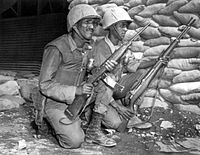Kagnew Battalion
| 1st, 2nd and 3rd Kagnew Battalions | |
|---|---|

Ethiopian Soldiers, part of the Kagnew Battalion, 7th Inf. Div., Korea, 1953
|
|
| Active | 1951–1965 |
| Country |
|
| Allegiance |
|
| Branch | Army |
| Type |
Infantry Battalion |
| Size | 6,037 soldiers in total |
| Part of | US 7th Infantry Division |
| Patron | Emperor Haile Selassie I |
| Engagements | Battle of Pork Chop Hill |
| Decorations | US Presidential Unit Citation |
| Commanders | |
| Notable commanders |
Col. Kebbede Guebre Major General Ingida Asrat |
Col. Kebbede Guebre
The Ethiopian Kagnew Battalions (Amharic: ቃኘው?) were three successive battalions drawn from the 1st Division Imperial Bodyguard sent by Emperor Haile Selassie I between June 1951 and April 1954 as part of the United Nations forces in the Korean War. Even after the armistice, a token Ethiopian force remained in the country until 1965.
Altogether, 3,158 Ethiopians served in Kagnew Battalions during the war.
"Kagnew" was the name of the warhorse of Ras Makonnen, Menelik II's General and the father of Haile Selassie during the First Italo-Ethiopian War. Military units from Imperial times would often adopt a name of a favored military commander and Ethiopian Warriors were often referred to interchangeably by the names of their war horses.
The regular Armed Forces of the Ethiopian Empire consisted of four Divisions roughly of 10,000 men with support armor and artillery elements and complementary Air and Naval forces. This numbered roughly 50,000 men and women. The 1st Division Imperial Bodyguard had primary responsibility for security in the North of the country including Eritrea. Each Kagnew Battalion was drawn completely from the officers and men of the 1st Division Imperial Body Guard or the Kebur Zabagna, sometimes also referred to as Ethiopia's "Royal" Guards. The troops selected for Korea were given intensive training in the mountains of Ethiopia for aclimatisation.
The Kagnews served with great distinction, principally alongside the 7th Infantry Division, and by all accounts (including the enemy's) acquitted themselves well in battle, suffering 121 dead and 536 wounded during the course of the conflict. At the conclusion of the war the Ethiopians were the only contingent that had no prisoners to collect from the North Koreans since no Kagnew soldier ever surrendered. They had the additional distinctions of having never been bested in battle during the war. The Kagnew Battalion engaged in combat 238 times and won every encounter, as both aggressors and defenders. Another distinction was that they never left their dead behind, and it was noticed that there never seemed to be dead bodies of Kagnew soldiers on the battlefield. This earned them the respect of their American colleagues, while fostering the belief among their opponents, who had often never even seen black people before, that they were superhuman.
...
Wikipedia
